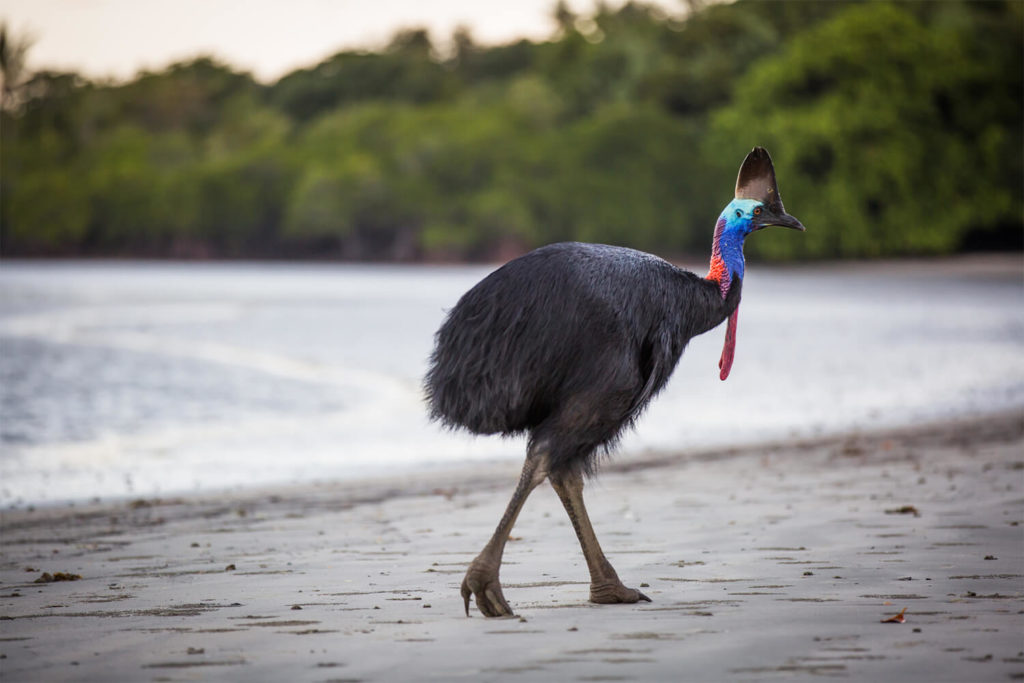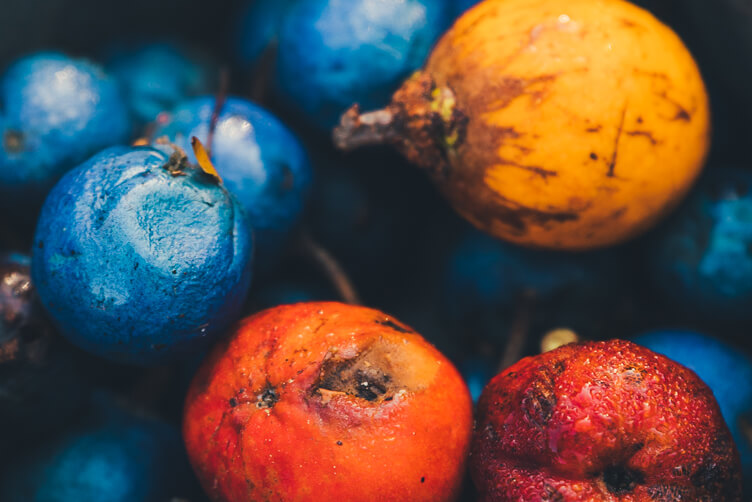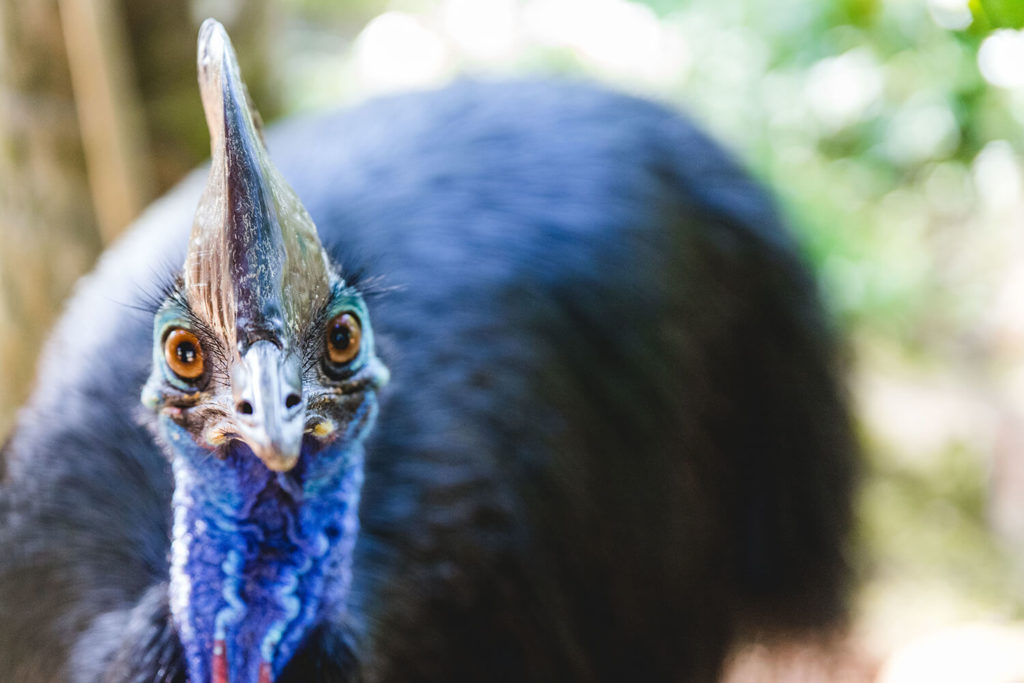TNQ Writer
There’s plenty of reasons to visit Cairns & Great Barrier Reef in summer – balmy weather, crystal clear reef visibility and pumping waterfalls – but what you might not know is it’s also the best time of year to spot Australia’s living dinosaurs and their chicks, cassowaries.
If you’re not familiar with this famous flightless bird, they are not your average canary – they’re a lean, fruit-eating machine, measuring upwards of 1.8 metres tall and tipping the scales at approximately 70kg.
While you can see cassowaries all year round (if you’re lucky), summer is the best time to clap eyes on their chicks who emerge from their forest-green shells and take their first footsteps.
Father cassowaries raise the chicks
The fact the southern cassowary is the only cassowary found on mainland Australia, has earnt spotting one a place on most travellers ‘must see’ list when visiting Tropical North Queensland.
What’s so special about this big bird? This guide will tell you everything you need to know.
Where are cassowaries found?
With an unlimited supply of fruiting trees at their claw-tips, it’s no surprise southern cassowaries call the Wet Tropics rainforest home.
You’re almost guaranteed to see them is along the aptly named Cassowary Coast, whether that be Etty Bay, Bingal Bay or Mission Beach where it’s a common summer sight to see dad taking the brood out for morning stroll.
There’s also regular cassowary sightings on the Atherton Tablelands, Kuranda, Cape Tribulation and the Daintree – and the yellow and black road signs are a good giveaway you’re in cassowary country.

Cassowary on Myall Beach, Cape Tribulation
Cassowary on Myall Beach, Cape Tribulation

Juvenile cassowary at Etty Bay
Juvenile cassowary at Etty Bay
What you may not know, is you can spot cassowaries along the Cape York Peninsula, where the dense rainforest vegetation and low levels of urban development make the perfect cassowary camouflage.
It’s hard to image how such a sizeable bird can do such a good job hiding, but cassowaries are notoriously private creatures and hard to spot, even with their distinct markings.
A lot of this has to do with their nomadic lifestyle wandering up to 2.35km² of territory and the fact their black bodies blend into the forest shadows, while their bright colours mirror the new growth within the forest.
Why are cassowaries important to the rainforest?
Every animal might contribute to the circle of life, but perhaps none more so than the cassowary, who is single-handily responsible for landscaping most of the UNESCO protected, Wet Tropics World Heritage Area.
Mother Nature might have intended a breathtaking bird, but she created a landscape gardener, with black glossy feathers, a vivid blue and purple neck and amber eyes. Only this gardener doesn’t use trowels or tools, but a three-pronged claw, which lets them cover great distances each day, scattering seeds with every step.
Their favourite brand of manure is their own, which is responsible for spreading the seeds of the rainforest trees – some of which are larger than an avocado pit. As one of only a handful of frugivores (fruit eaters) in the forest, cassowaries then disperse the seeds across the rainforest in large purple poops resembling a fruit smoothie.

Cassowary diet consists over 238 species of plant
Cassowaries aren’t fussy eaters and have no problems meeting their 5:2 quota, with over 238 species of plants recorded in their diet, with 50-plus species of seeds in every deposit to sustain Tropical North Queensland’s famous foliage. They do eat 4-5kg of fruit each day, after all.
For some trees within this UNESCO-worthy landscape, cassowaries are their only vehicle for reproduction, with many seeds like the Ryparosa kurrangii only really germinating inside the bowel of a cassowary.
How to be cass-o-wary?
You might have heard cassowaries have a reputation for being cranky and with clawed feet and a solid noggin, they can inflict serious injuries to people who close in on their territory.
All visitors are encouraged to stay alert in the forest and be aware of our fruit-eating, feathered friends. As with any wild animal, their behaviour can be unpredictable and territorial, which is why you should never approach a cassowary, especially one with chicks.
Cassowaries are best viewed from a distance, but if you do find yourself in the unlikely situation where you’re closer than you’d like, back away slowly and put something between you and the bird as a form of protection.

Always be casso-wary when driving through cassowary country
Bear in mind most cassowaries are more content in finding their next fruit cocktail than seeing what you’re up to – so there is no need to panic. More often than not, it’s us humans that pose a greater risk to cassowaries than the other way round.
Remember to slow down when you’re in cassowary country. Road accidents are responsible for more cassowary deaths than anything else.
What’s so special about them?
Dating back 65 million years – the cassowary is no stranger to evolution, standing out with its helmet head, blue neck and red wattles. In fact, the cassowary belongs to a group of birds called Ratities, which are recognised as the most ancient and relict of all birds on the planet.
While it might be quite dissimilar to other birds of the forest, it does share its parenting approach in common with another flightless bird – the male emperor penguin who also incubates the eggs on his own.

Cassowaries belong to a group of birds called Ratities which is the most ancient and relict of all birds
After a short breeding season, it’s the male cassowary who is called to arms to do the child care, sitting on the eggs and looking after the chicks until they are ready to leave the nest somewhere between 9 -18 months of age after an unceremonious ousting by dad.
In fact, it’s well documented that males will often sit with the eggs for two months, only leaving once or twice for a gulp of water. Where’s mum in all of this? Likely cavorting with four to five other males in her territory.
Cassowary’s history and lineage is well documented beyond science textbooks, with cassowaries playing a role in the stories of rainforest Aboriginal People. Take for instance its helmet which was said to be formed after running into a large rock which split onto its head, eventually earning the bird its title as the fearless leader of the forest. You’ll want to book a rainforest tour with a Traditional Owner to hear the stories firsthand though.
When to spot cassowaries?

If you don't spot any in the wild, visit one of the wildlife parks around the region
If you don't spot any in the wild, visit one of the wildlife parks around the region

Billy Tea Safaris explore the Daintree, where you might spot cassowaries
Billy Tea Safaris explore the Daintree, where you might spot cassowaries

Tours on Kuranda Riverboat often spot this ancient bird
Tours on Kuranda Riverboat often spot this ancient bird
While you can see cassowaries year-round, your best chance of spotting the little chicks is summer, when they start a crash course in fruit fossicking under the careful supervision of dad.
While they might follow in their dad’s claw-prints, baby cassowaries won’t look like him for a little while yet. Fresh chicks sport a striped dark brown and cream feather coast, which will change to their forever feathers at around six months of age.
No matter when you visit, it’s important you make time in your Cairns itinerary to see this famous bird, because right now the cassowary is endangered, with an estimated 4200 birds in the wild.
The best way to see them is with a guided rainforest tour as your hosts will likely know the best spots to see them in their natural habitat, although like anything in the rainforest, there are no guarantees of a sighting.













